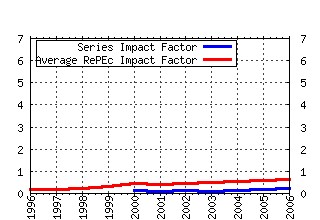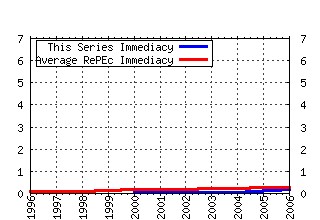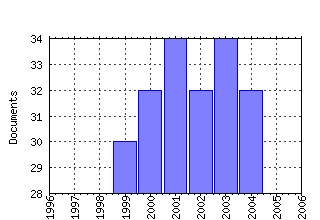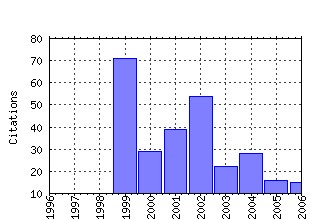
|
|
||||||||||||||||||||||||||||||||||||||||||||||||||||||||||||||||||||||||||||||||||||||||||||||||||||||||||||||||||||||||||||||||||||||||||||||||
Population and Development Review Raw citation data, Impact Factor, Immediacy Index, Published documents, Citations received, , Most cited papers , Recent citations and documents published in this series in EconPapers.
Most cited documents in this series: (1) RePEc:bla:popdev:v:25:y:1999:i:1:p:85-120 The Effect of Household Wealth on Educational Attainment: Evidence from 35 Countries (1999). (2) RePEc:bla:popdev:v:28:y:2002:i:4:p:641-680 The Emergence of Lowest-Low Fertility in Europe During the 1990s (2002). (3) RePEc:bla:popdev:v:27:y:2001:i:1:p:103-132 Cohort Reproductive Patterns in Low-Fertility Countries (2001). (4) RePEc:bla:popdev:v:25:y:1999:i:2:p:253-288 Is Fertility Behavior in Our Genes? Findings from a Danish Twin Study (1999). (5) RePEc:bla:popdev:v:30:y:2004:i:2:p:195-220 Is Lowest-Low Fertility in Europe Explained by the Postponement of Childbearing? (2004). (6) RePEc:bla:popdev:v:25:y:1999:i:2:p:211-228 Is Low Fertility a Temporary Phenomenon in the European Union? (1999). (7) RePEc:bla:popdev:v:29:y:2003:i:3:p:448-458 Causal Analysis in Population Research: An Economists Perspective (2003). (8) RePEc:bla:popdev:v:26:y:2000:i:3:p:554-559 On the Quantum and Tempo of Fertility: Limits to the Bongaarts-Feeney Adjustment (2000). (9) RePEc:bla:popdev:v:27:y:2001:i:1:p:33-63 Fertility, Education, and Development: Evidence from India (2001). (10) RePEc:bla:popdev:v:31:y:2005:i:3:p:529-535 Explaining Asias Missing Women: A New Look at the Data (2005). (11) RePEc:bla:popdev:v:28:y:2002:i:3:p:515-537 Muslim and Non-Muslim Differences in Female Autonomy and Fertility: Evidence from Four Asian Countries (2002). (12) RePEc:bla:popdev:v:30:y:2004:i:4:p:707-726 Religion as a Determinant of Economic and Demographic Behavior in the United States (2004). (13) RePEc:bla:popdev:v:28:y:2002:i:1:p:13-29 How Long Do We Live? (2002). (14) RePEc:bla:popdev:v:33:y:2007:i:4:p:667-701 New Evidence on the Urbanization of Global Poverty (2007). (15) RePEc:bla:popdev:v:29:y:2003:i:2:p:255-275 The Benefits from Marriage and Religion in the United States: A Comparative Analysis (2003). (16) RePEc:bla:popdev:v:26:y:2000:i:3:p:427-439 Gender Equity in Theories of Fertility Transition (2000). (17) RePEc:bla:popdev:v:26:y:2000:i:1:p:81-115 Absent and Problematic Men: Demographic Accounts of Male Reproductive Roles (2000). (18) RePEc:bla:popdev:v:32:y:2006:i:3:p:511-528 Happily Ever After? Cohabitation, Marriage, Divorce, and Happiness in Germany (2006). (19) RePEc:bla:popdev:v:28:y:2002:i:3:p:419-443 The End of the Fertility Transition in the Developed World (2002). (20) RePEc:bla:popdev:v:25:y:1999:i:2:p:229-251 How Influential Are Demography Journals? (1999). (21) RePEc:bla:popdev:v:27:y:2001:i:2:p:259-281 Prenatal Sex Determination and Sex-Selective Abortion in Rural Central China (2001). (22) RePEc:bla:popdev:v:30:y:2004:i:4:p:579-624 The Economic Effects of Immigration into the United Kingdom (2004). (23) RePEc:bla:popdev:v:31:y:2005:i:1:p:113-126 Why Is Fertility Lower in Wealthier Countries? The Role of Relaxed Fertility-Selection (2005). (24) RePEc:bla:popdev:v:28:y:2002:i:2:p:275-284 Sex Differentials in Undernutrition: A Look at Survey Evidence (2002). (25) RePEc:bla:popdev:v:33:y:2007:i:1:p:149-170 Approaching the Limit: Long-Term Trends in Late and Very Late Fertility (2007). (26) RePEc:bla:popdev:v:25:y:1999:i:4:p:757-778 Urban Growth in Developing Countries: A Review of Projections and Predictions (1999). (27) RePEc:bla:popdev:v:25:y:1999:i:1:p:1-31 Family Demography, Social Theory, and Investment in Social Capital (1999). (28) RePEc:bla:popdev:v:25:y:1999:i:2:p:323-343 Indias Falling Sex Ratios (1999). (29) RePEc:bla:popdev:v:32:y:2006:i:3:p:485-510 Low Fertility and the State: The Efficacy of Policy (2006). (30) RePEc:bla:popdev:v:26:y:2000:i:2:p:235-261 Relative Cohort Size: Source of a Unifying Theory of Global Fertility Transition? (2000). (31) RePEc:bla:popdev:v:29:y:2003:i:3:p:349-374 A New Approach to Explaining Fertility Patterns: Preference Theory (2003). (32) RePEc:bla:popdev:v:28:y:2002:i:2:p:285-312 A Turning Point in Gender Bias in Mortality? An Update on the Number of Missing Women (2002). (33) RePEc:bla:popdev:v:27:y:2001:i:4:p:687-712 Womens Autonomy in India and Pakistan: The Influence of Religion and Region (2001). (34) RePEc:bla:popdev:v:31:y:2005:i:4:p:645-674 Inequality in Life Spans and a New Perspective on Mortality Convergence Across Industrialized Countries (2005). (35) RePEc:bla:popdev:v:28:y:2002:i:1:p:77-104 Cigarette Use and the Narrowing Sex Differential in Mortality (2002). (36) RePEc:bla:popdev:v:30:y:2004:i:2:p:239-268 The Determinants of Gender Equity in India: Examining Dyson and Moores Thesis with New Data (2004). (37) RePEc:bla:popdev:v:32:y:2006:i:3:p:401-446 Immigration and Ethnic Change in Low-Fertility Countries: A Third Demographic Transition (2006). (38) RePEc:bla:popdev:v:26:y:2000:i:2:p:209-234 The Limits to Low Fertility: A Biosocial Approach (2000). (39) RePEc:bla:popdev:v:27:y:2001:i:2:p:283-302 Health Interventions and Health Equity: The Example of Measles Vaccination in Bangladesh (2001). (40) RePEc:bla:popdev:v:26:y:2000:i:4:p:643-689 Population and Resources: An Exploration of Reproductive and Environmental Externalities (2000). (41) RePEc:bla:popdev:v:27:y:2001:i:4:p:713-738 Spatial Patterns of Fertility Transition in Indian Districts (2001). (42) RePEc:bla:popdev:v:30:y:2004:i:1:p:25-56 When Does Religion Influence Fertility? (2004). (43) RePEc:bla:popdev:v:32:y:2006:i:2:p:293-321 Reexamining Chinas Fertility Puzzle: Data Collection and Quality over the Last Two Decades (2006). (44) RePEc:bla:popdev:v:30:y:2004:i:4:p:647-672 Are Parents Investing Less Time in Children? Trends in Selected Industrialized Countries (2004). (45) RePEc:bla:popdev:v:29:y:2003:i:1:p:47-71 Shifting Childrearing to Single Mothers: Results from 17 Western Countries (2003). (46) RePEc:bla:popdev:v:30:y:2004:i:2:p:269-295 Sex Differentials in Childhood Feeding, Health Care, and Nutritional Status in India (2004). (47) RePEc:bla:popdev:v:31:y:2005:i:1:p:57-84 How Far Has Fertility in China Really Declined? (2005). (48) RePEc:bla:popdev:v:33:y:2007:i:2:p:247-287 On the Determinants of Mortality Reductions in the Developing World (2007). (49) RePEc:bla:popdev:v:26:y:2000:i:3:p:560-564 On the Quantum and Tempo of Fertility: Reply (2000). (50) RePEc:bla:popdev:v:29:y:2003:i:2:p:163-196 Science, Modernity, and the Making of Chinas One-Child Policy (2003). Recent citations received in: | 2006 | 2005 | 2004 | 2003 Recent citations received in: 2006 (1) RePEc:acb:cbeeco:2006-467 Demographic Change and the Labour Supply Constraint (2006). Australian National University, College of Business and Economics, School of Economics / ANUCBE School of Economics Working Papers (2) RePEc:gdm:wpaper:1106 Chinas Growth to 2030: Demographic Change and the Labour Supply Constraint (2006). Program on the Global Demography of Aging / PGDA Working Papers (3) RePEc:iza:izadps:dp2494 Life Satisfaction and Economic Outcomes in Germany Pre- and Post-Unification (2006). Institute for the Study of Labor (IZA) / IZA Discussion Papers (4) RePEc:pse:psecon:2006-35 Born to be mild? Cohort effects dont explain why well-being is U-shaped in age. (2006). PSE (Ecole normale supérieure) / PSE Working Papers (5) RePEc:scp:wpaper:06-58 Life Satisfaction and Economic Outcomes in Germany Pre- and Post-Unification (2006). Institute of Economic Policy Research (IEPR) / IEPR Working Papers Recent citations received in: 2005 Recent citations received in: 2004 (1) RePEc:iza:izadps:dp1390 Religion as a Determinant of Economic and Demographic Behavior in the United States (2004). Institute for the Study of Labor (IZA) / IZA Discussion Papers Recent citations received in: 2003 Warning!! This is still an experimental service. The results of this service should be interpreted with care, especially in research assessment exercises. The processing of documents is automatic. There still are errors and omissions in the identification of references. We are working to improve the software to increase the accuracy of the results. Source data used to compute the impact factor of RePEc series. |
||||||||||||||||||||||||||||||||||||||||||||||||||||||||||||||||||||||||||||||||||||||||||||||||||||||||||||||||||||||||||||||||||||||||||||||||




